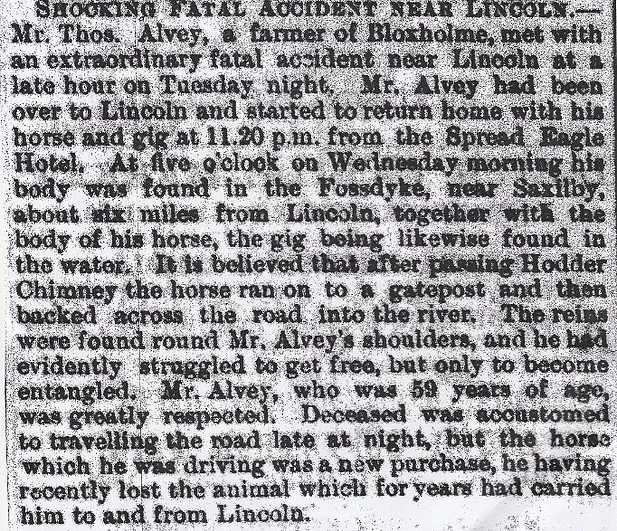1/ Skidbrooke Church near Saltfleet, (Ghosts?/Satanic Rituals)

Me and some mates were driving around here late one night in the late Eighties or early nineties,(I remember we were in an Austin Maestro, so you do the maths) when we spotted lights at the Church, but left it alone and thought we’d check it out later. This was when St Botolph’s had a front door. Went back later and found a Pentagram in wax on the floor, plus an old blanket. Ran like Usain Bolt! The church at Skidbrooke when mentioned to people, they say paranormal activity or ghosts or the Satan worshipper’s who chose hallowed and consecrated ground to worship Beelzebub, very clever! Ghost hunting groups from Lincolnshire and Norfolk got some weird sightings and photo’s and heard strange noises. Let’s get one thing straight, it’s a church on marshland and is miles from anywhere and infested with bats and other nocturnal creatures. I’ve been a few times, but never heard or seen anything unusual. But you get this feeling, whether that’s the past history of the place, graffiti, pentagrams. You’re bound to feel uneasy and it’s a shame as it is a lovely building with a long history. In 2004 there was a report of animal sacrifices, and got the nickname of the “Demon Church”.
2/ Well Vale Drowning, July 1888 (Well Vale has two large ponds/Still there !)
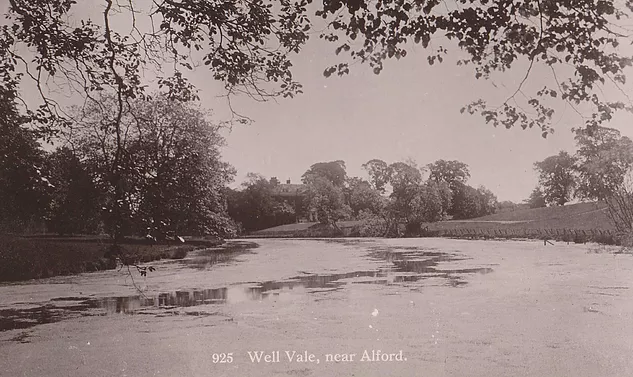
James Lawson, son of John Lawson, the head gardener at the Hall, was drowned in the lake or lower pond, at the back of the Hall. He was only nineteen and had served as an apprentice to a butcher in Alford, then left eighteen months ago and joined the navy, and was on board a training ship where he learned to swim. He was let go due to having a cataract in one eye, which destroyed the sight and the eye was removed. The brother, 14-year-old Edward, said he was by the lake with James when he said he’d like to go for a dip so they got undressed and dived into the lake where the water was shallow, and you could stand up in it. He then got into the boat and rowed to the centre of the lake then dived in from there. He called out “Oh” and threw his arms up, then he vanished. The body was found after an hour or so by police who dragged the pond. The body was in twelve feet of water, and he was naked. The length of time he had been under the water there was no need to try and restore animation. The verdict was one of “Accidental drowning” and probably was caused by the teenager getting cramp or something similar.
3/ Yarburgh Church (Vicars Suicide), September 1851
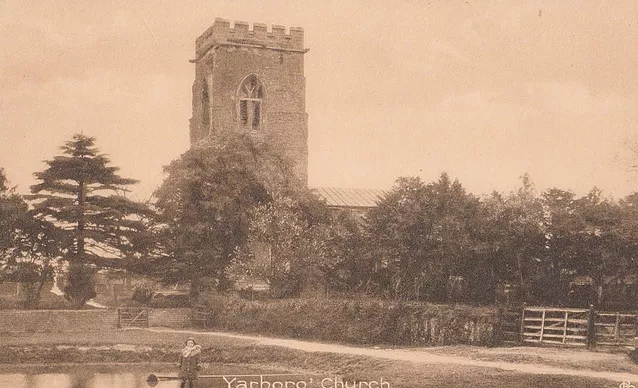
The little village of Yarburgh (not Yarborough) near Louth, got one hell of a surprise one morning when they found out that their vicar, the Reverend J.C.Umpleby had killed himself. He left the Rectory with a double-barrelled gun. When a domestic servant saw that a gun was missing from the cabinet, a search was made by friends and workers alike. A groom discovered him in a shrubbery next to the garden with a gaping head wound and totally lifeless. Reverend Umpleby had been despondent recently but he was never considered suicidal, being a man of the cloth.
4/ Yarburgh Poisoning, January 1867
Eliza Graves, daughter of James Graves, aged only three months died on December 31st, 1866, by accidentally being given laudanum by its mother. The father had purchased at Mr Norris’s shop, a small bottle of what he believed to be cough mixture, which he had previously taken. By mistake, Mr Norris gave him laudanum, which he thought he asked for, but the evidence was not clear on this point. The mother gave her daughter a teaspoonful of the laudanum with the father taking the remainder, from which he was very ill. The infant died next day. The jury thought it was given the poison by mistake but also commented on the carelessness of both Mr Norris, and the parents, in this tragedy.
5/ Yarburgh Drowning, September 1880
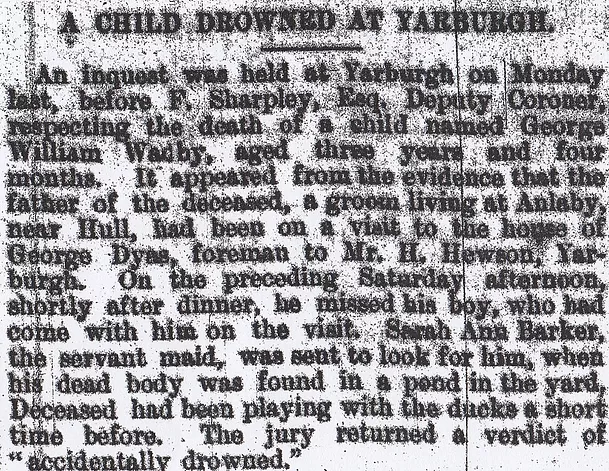
Cadeby Hall ( The Nelsons)

6/ Cadeby/Limber, February 1878
The gentleman known as George Nelson, a farmer and landowner in this district, expired one Friday night at his residence in Limber, having only been taken ill on the previous Tuesday. The cause of death is said to be epilepsy. He succeeded his father a few years ago in the occupation of a large farm on the Brocklesby estate and was the owner and lord of the manor at the hamlet of Cadeby, occupied by his brother-in-law, Mr J.W.Kirkham. He was a captain in the Royal North Lincoln Militia, and a member of the Lincolnshire Light Horse. Deceased was a widower, and had two children.
7/ Cadeby Hall Death, January 1885
I read a book when I was a teenager,”The Haunted Realm”, by Simon Marsden, who always took those foreboding black and white photograph’s of creepy old houses and castles, throughout Britain. In it was Cadeby Hall, it mentioned that it was built on the site of an ancient monastery, underground passages and that it was haunted. A young lad disappeared and servants and family searched everywhere but never found the boy. Some years later a skeleton was found in a tree hollow. The mother then put a curse on Cadeby. There was also the story of how a ghostly coach and horses would come up the driveway, whenever there was about to be a death in the family. This should have occurred in January of 1885, because young George Nelson aged about sixteen was driving back to Cadeby Hall from a trip rabbiting, when a storm began to brew and his horse had been scared by either thunder or lightning. It reared up and veered into a ditch about three hundred yards from the lodge gates. He was killed on the spot and when he never returned home there was a search where he was found in the ditch, with the upturned cart. He died from suffocation being unable to get free from the debris. A grave is by the side of the road on Barton Street, near to where the accident occurred. It simply reads:-
This stone marks the spot, where George Nelson, of Cadeby Hall, was killed January 16th,1885. Aged 16 years. In the midst of life, we are in death.”
Later on, it told of how he was interred at the family brick grave at Limber. The “Dead March” was played as his coffin entered the church and handsome wreaths and crosses from his schoolfellows at Bedford Grammar School. The gravestone at the side of the road was of Yorkshire sandstone, has been worked in the yard of Mrs Woodward.
8/ Cadeby Hall, November 1869 (Concealment of Birth)
The body of a newly-born male child, which was discovered on the 12th November in a vault of a privy connected to Cadeby Hall. The housekeeper, Hannah Hill, deposed: I suspected a servant girl named Mary Laking aged sixteen, of having given birth to a child. I accused her and she denied the fact.the witness found the child and sent for P.C. Booth, who took the body and apprehended the girl for concealing the birth thereof. Mr George, a surgeon of North Thoresby, held a post-mortem and gave evidence that the child had never breathed. A verdict of “Found Dead”.
December 1869
Mary Laking aged sixteen, a domestic servant, pleaded guilty to the charge of endeavouring to conceal the birth of her child, at Cadeby on 11th November 1869. – Six months imprisonment with hard labour.
9/ Wyham-cum-Cadeby Drowned Child, March 1861
A child of six years was accidentally drowned at Wyham. Three or four boys and girls on their way to school, some of them left two of the younger ones behind near a pond when the elder of the two overbalanced itself and fell down the bank. The companion aged five years ran to the school and told of the accident, but twenty minutes had elapsed before he was brought out of the water, and all means to revive the child proved ineffectual. The Reverend F.W.Mann, of Wyham Rectory, and Mrs Mann, exerted themselves most strenuously in endeavouring to recover the child. Verdict:- “Found drowned”
————–There is a “Pond House” on Barton Road, between Wyham and Utterby Primary School.—————–

10/ Wyham Death, September 1877 (Clayton got caught up in something similar to above)

11/ Tetney, December 1898 (Oldest Bellringer Dies)
The oldest bellringer in England, ninety-seven-year-old Matthew Laking has died at Tetney. He started campanology when he was just a 15-year-old boy and continued for the next eighty-two years. He rang bells at the death of George the Third, the ascension of George the Fourth, William the Fourth, and Queen Victoria.
12/ Tetney, August 1860 (Laudanum Addiction)
Ann Colbeck was found dead in bed at her home in Tetney. Susannah Croft aged fourteen, took her some tea and sent Croft’s sister to go and fetch some laudanum which she drank off at once, then filled a teacup half filled it with rum then downed it in one. Eliza Croft, the mother of the witness, said she and Mary Plumtree went to see her and when they arrived the house was pitch black. They got a light and went upstairs and saw her lying on the bed with her head in the bottom drawer, face down. There was a broken glass nearby, and the witness had often seen her in a state of intoxication. Another witness stated that he had seen her take six ounces of laudanum a day and she was addicted to it. A verdict of Natural Death brought on by excessive drinking.
13/ Waithe Church, (Grimsby/Louth) January 1862 (Newly built village)
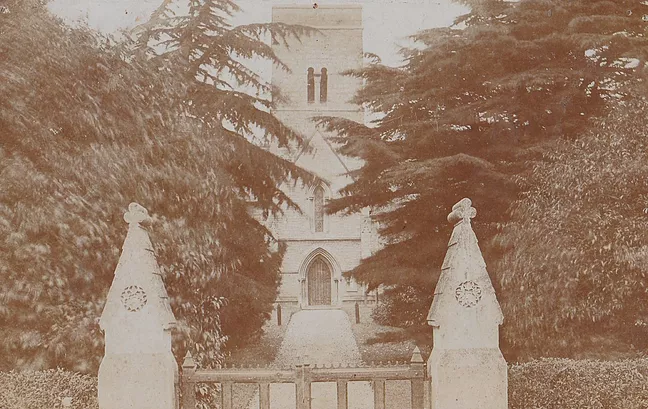
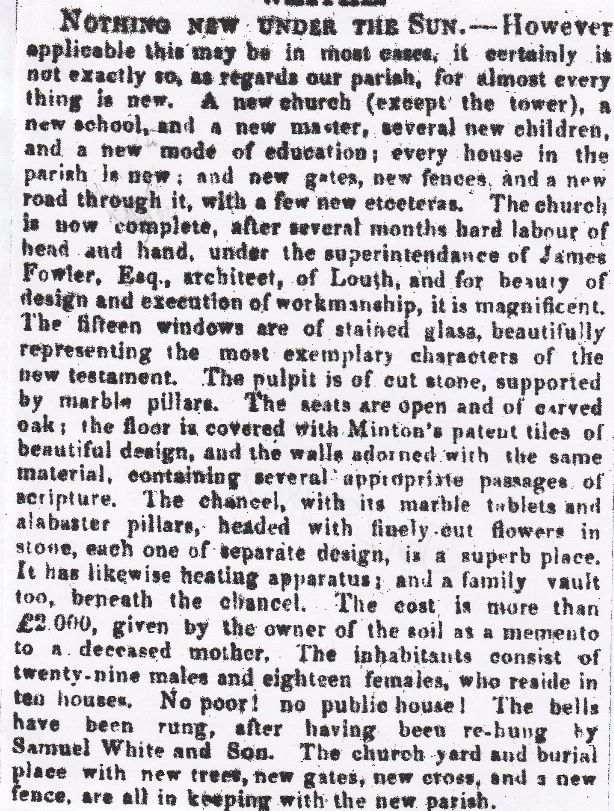
14/ Utterby Fatal Accident, September 1919
Mr Henry Hunt of the minesweeper H.M.S. Oakley was killed in a car crash at Utterby, midway between Louth and Grimsby. The car, which had four male passengers and the driver, ran into level-crossing gates. The others escaped uninjured.
15/ Utterby, September 1882 (Illegitimate Child)
An inquest was held at Utterby, concerning the body of the illegitimate child of Ellen Wood. The mother had been living in a situation at Hull but had lately come to Utterby to her parents in consequence of her condition. She was called to give evidence on the death of the child and stated that whilst in her chamber she was suddenly taken ill with a fainting fit. When she recovered consciousness, found she had been delivered of a child, which was lying dead beside her. The post-mortem failed to enable the medical man to say positively that the child had lived and the proceedings terminated. The mother had had two children previously.
16/ Usselby near Market Rasen, December 1861 (Concealing Birth)
Ann Dixon aged twenty-one, was charged with unlawfully endeavouring to conceal the birth of her female child at Usselby on September 8th,1861. The prisoner pleaded guilty and his Lordship in passing sentence observed, that if he had any idea that she had been concerned in taking away the child’s life, he should have passed a more severe sentence than he now intended doing. He then sentenced her to three months imprisonment with hard labour.
17/ Usselby, February 1887 (Concealment of Birth)
In a case scarily similar to above, again in Usselby, a hidden gem of a place (to me anyway), just outside of Market Rasen. This was Annie Kirman, a twenty-three-year-old domestic servant on a charge of murder of a female child, of which she had recently been delivered at Usselby. They, however, returned a true bill for concealment of birth, to which indictment prisoner pleaded guilty and she was sentenced to three months imprisonment, with hard labour.
18/ Usselby Train Crash, January 1881
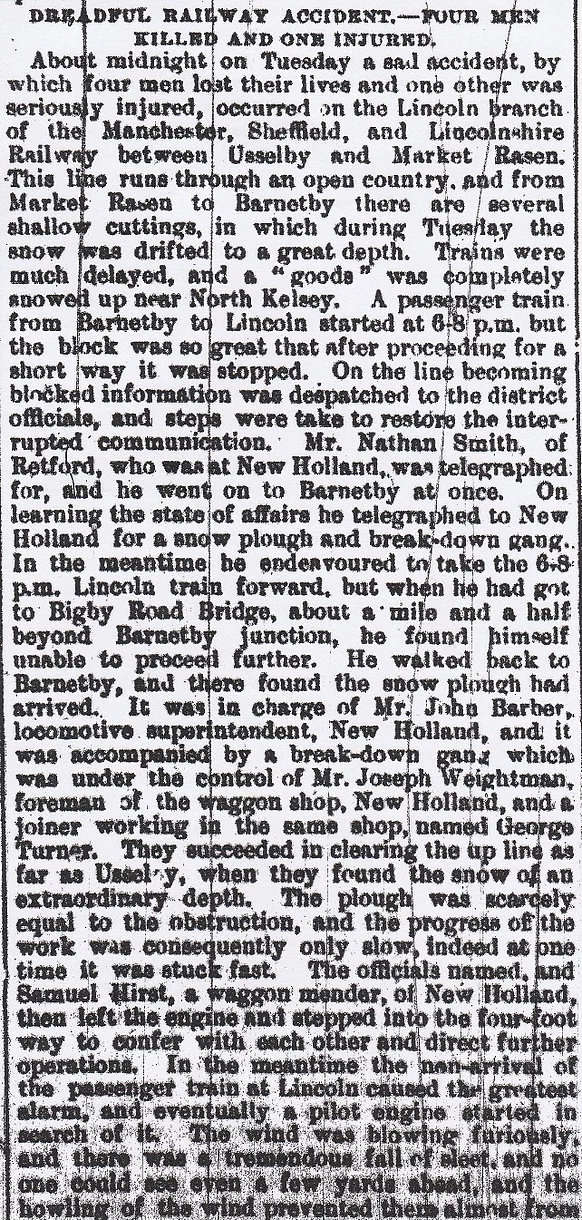
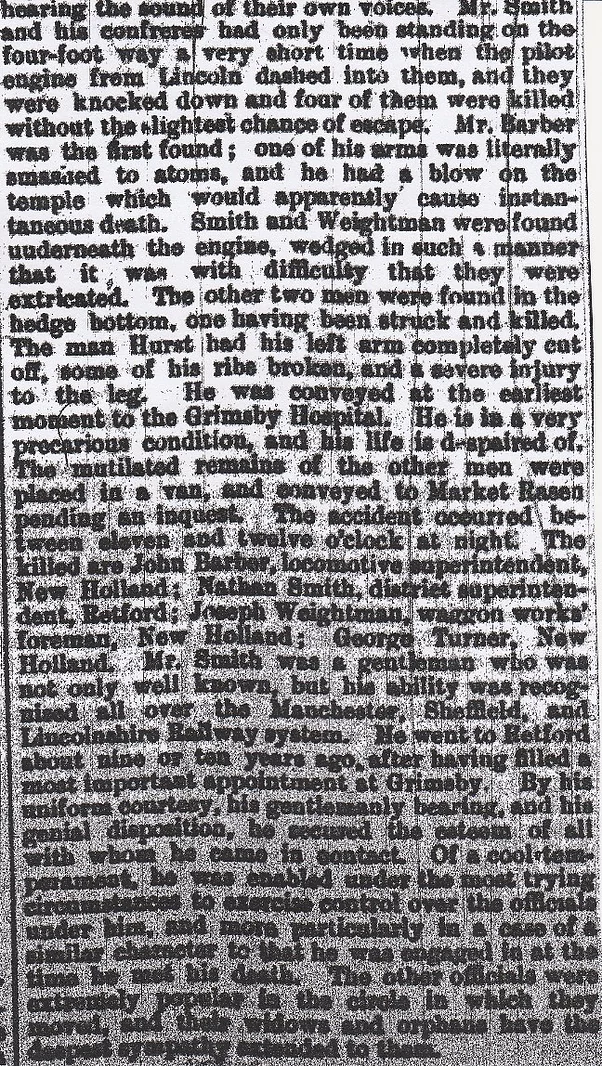
19/ Skendleby Church Death, July 1887
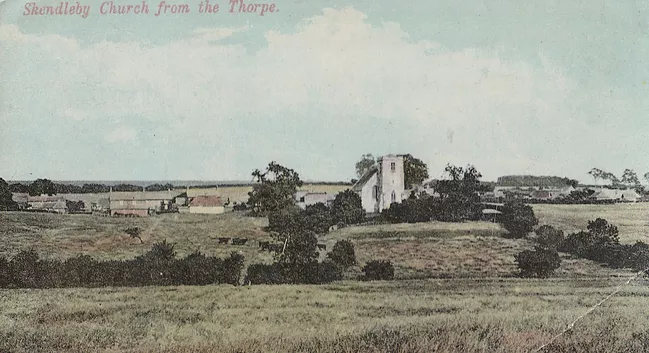
A singular fatality occurred at the church in Skendleby near Spilsby.The evening service at the church commences at 6-30 p.and just as the bellringers were getting ready to ring the church clock, to strike six, the cord suspending the striking weight snapped and the weight fell forty feet, hitting a campanologist named Frederick Hutchinson on the head, killing him outright. The weight weighed just under a ton.
20/ Skendleby, May 1897 (Two-headed Baby)
A woman in Skendleby gave birth to a child with two heads and two backbones, with a rudimentary arm projecting between the heads. The child which was born dead was in other respects perfectly normal.
21/ Skendleby Vicarage, July 1869 (Attempted Murder/Suicide)
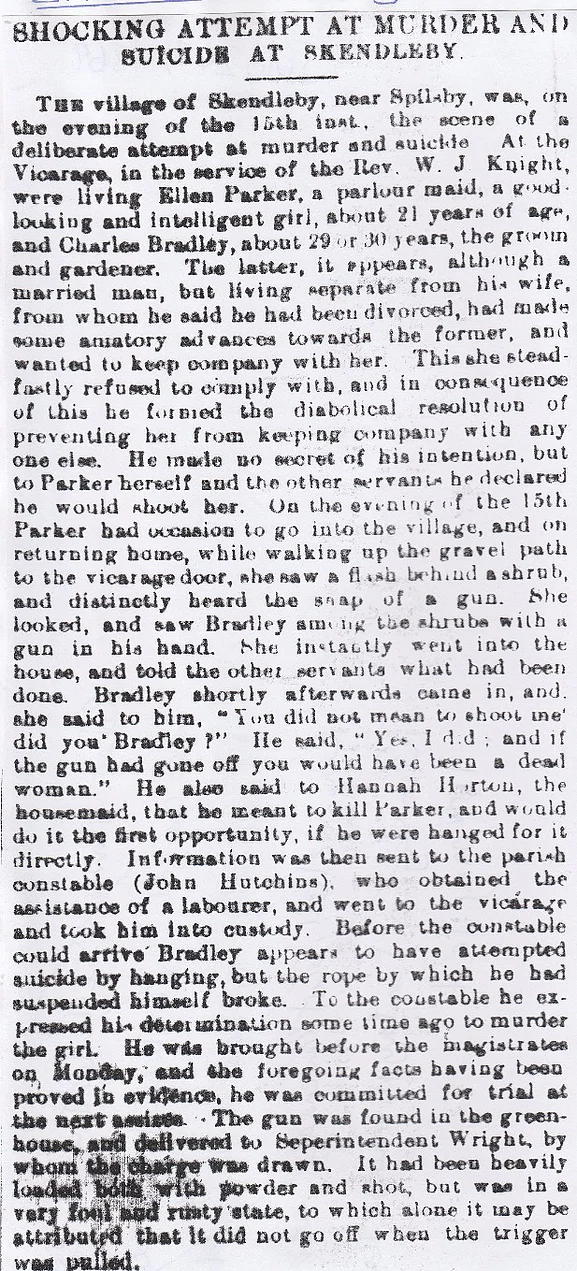
The verdict a week later went:- Charles Bradley aged thirty-eight, gardener, as charged with feloniously attempting to discharge a gun loaded with powder and shot, at Ellen Parker with intent to kill her at Skendleby on the 15th July. Prisoner pleaded guilty to the charge of intending to do grievous bodily harm. This plea was accepted and no evidence was offered on the count for intending to murder and he was sentenced to five years penal servitude.
22/ Saltfleetby Suicide, February 1866
Mrs Richardson, the widow of the late Thomas Richardson of Saltfleetby, committed suicide by taking three-pennyworth of Battle’s Vermin Killer. The deceased had been in a desponding state for some time and had evidently contemplated committing the rash act, having sent to the shop for the poison on a Wednesday. Verdict:- “Deceased destroyed herself, whilst labouring under temporary insanity”.
23/ Saltfleetby Fatal Accident, February 1881
A painful incident occurred in the parish of Saltfleetby when a little girl of six years of age, daughter of Mr Riggall of Trusthorpe was spending some weeks with her aunt and uncle at their residence, Red Leas. On Monday the Riggall’s were taking the girl home in a vehicle and while passing over a narrow wooden bridle-bridge which spans a drain, the wheel slipped off. Mr Riggall was leading the horse at the time but couldn’t prevent an upset, and the woman and girl were thrown into the water. Miss Riggall was rescued but her niece was under the trap some ten minutes before she could be extracted when life was then extinct.
24/ Saltfleetby St Clements, June 1876 (Slept with the corpse!)
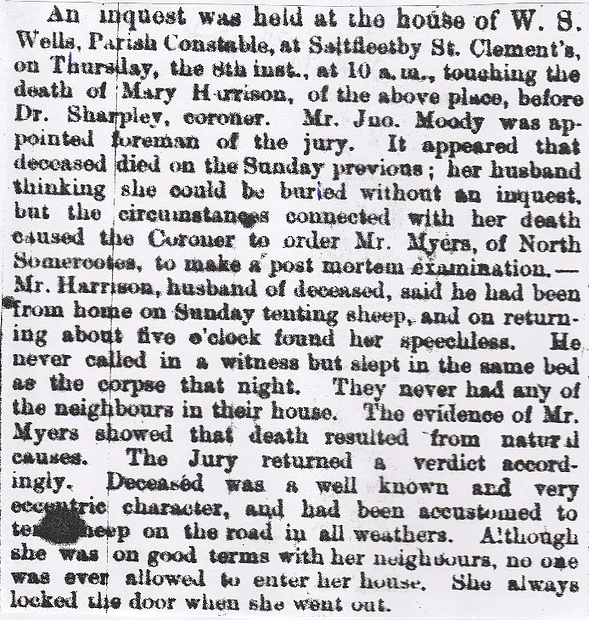
25/ Saltfleetby St Peter’s, September 1879 (Child Drowned)
William Fox aged twenty months, drowned in a horse pond in his father’s yard. The father, Marshall Fox, a farmer, said he was in the house a few minutes before this happened. The mother was skimming some milk and missed the child, so went to look for him and saw his body in the water. They tried to restore animation at a neighbour’s house but this failed to bring a result. It was here that a statement from the mother was due to be heard but she was ill in bed, due to the dreadful occurrence. After the incident, she had tried to place him in a hot bath and kept rubbing him and moving him about for about an hour but to no avail. There was a gate between the house and the pond but the string wasn’t on it. It is presumed the child’s bonnet blew off and he tried to get it from the water, then fell in, as the bonnet was in the pond as well.
26/ Saltfleetby Death,(Prussian Queen Inn) December 1897
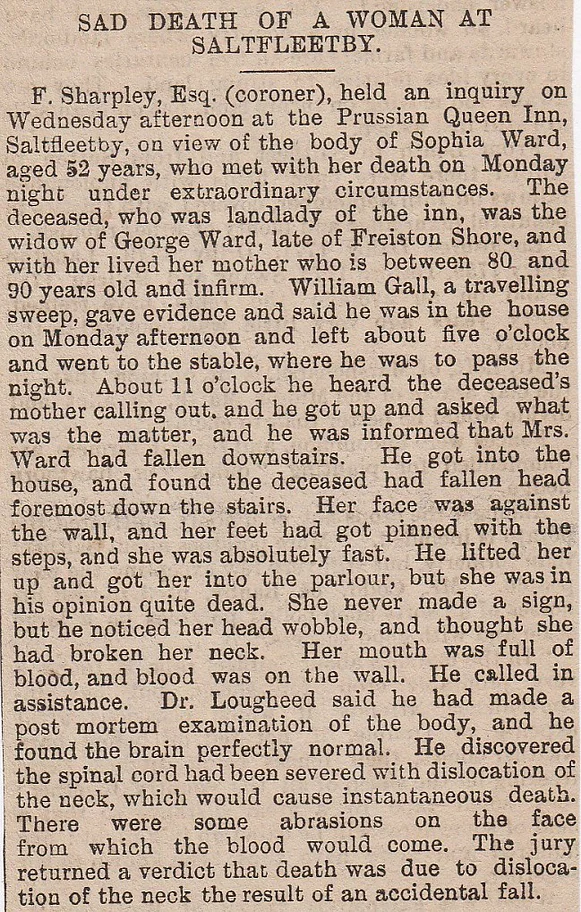
27/ Saltfleet Drowning, December 1874
John Houlden was an elderly man who was employed with his horses and cart to unload a ship that ran aground near Saltfleet, that was laden with timber. They were clearing it so that they could get her afloat again. A storm came in on the night time and he lost his way and was drowned. His corpse was discovered the following day along with the cart, but the horses were missing. “Accidentally Drowned”.
28/ Saltfleet, December 1884 (Fatal Accident)
Two vessels ran aground off Saltfleet and some men were employed to heave it out, the Ocean Bell being the name of the vessel when Charles Humberstone was knocked down by a tow rope which broke away. Whether he was killed by the rope hitting him or the fall down after it struck him, is uncertain. The Humberstone family who has resided at North Somercotes for several years have been lamentably unfortunate; two others were drowned; one, who was a painter, fell whilst at work and was killed; and another burned to death. He was thirty-three and leaves a widow and two children.
29/ Saltfleet Haven, February 1882 (Five Lives Lost)
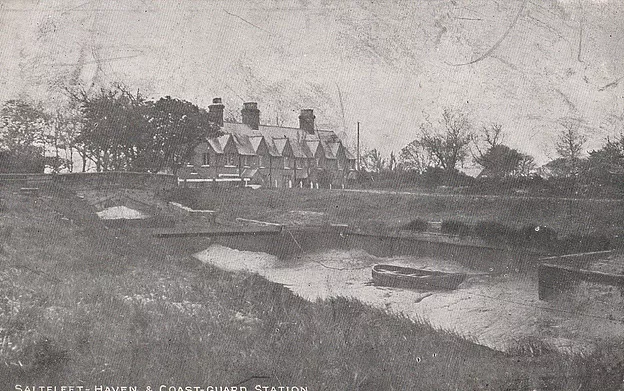
The thirty-nine-ton sloop “Try”, captained by John Adams of Saltfleet, along with his wife and three kids on board were going from Manby Main near Rotherham to Saltfleet, with a cargo of coal. The vessel began to leak and the vessel was anchored, and then the anchoring broke, they began to drift. It was seen to be in trouble by the coastguard station, above. The mother and a mate and the three children died…Robert Adams, Robert Adams the younger, Herma Adams and Louise Adams died on the Sunday morning on board the “Try”, on the shore of the German Ocean (North Sea) in the parish of Saltfleetby St Clements from exposure to wet and cold and that Harriet Adams died at the house of J.Stubbs, Saltfleetby St Clements from exposure on the same vessel.
30/ South Somercotes, February 1870 (Child Burned to Death)
Charles Edward, son of Mr Samuel Spendlove, an agricultural labourer who was aged five years, and was burnt to death on the 1st of February. It appears the mother was out charing and the little fellow was left at home with a sister not much older than himself, when his pinafore caught fire and he ran out of doors with all the clothes burnt off his back. Accidental burning.
31/ South Somercotes, November 1888
Robert Hundleby, a farmer, was with Robert Houlden at Louth Market and had enjoyed a few jars together. Absolutely drunk as skunks they drove home together and when about five miles from home, Hundleby got out and Houlden drove off. Hundleby’s body was discovered in a ditch by the roadside and had been there since the previous evening. Houlden said he could remember very little of what occurred that night, because of the drink. The Coroner told him off for his behaviour and cruelty. Deceased suffocated by drowning.
32/ Thorganby near Caistor, November 1904 (Bicycle Fatality)
Robert Burnett, a blacksmith from Thorganby, was going down Rothwell Hill on a bicycle late one night and he crashed into a gentleman named Berridge. Both men lay on a heap on the ground with Berridge appearing to be severely hurt. Burnett got up and walked with his broken bike, arrived home, then collapsed in a heap. He died the next morning from internal injuries and shock. Berridge is also in a precarious condition.
33/ Theddlethorpe (Body Washed Ashore) May 1876

34/ Theddlethorpe, August 1866
Little William Richardson, son of the local butcher, George Richardson, was playing near the side of a large ditch that runs right in front of the house. He slipped in and drowned in the relatively shallow waters.
35/ Theddlethorpe, (Four Coastguards Missing) February 1903
The deaths of four local coastguards were reported from Theddlethorpe. At dinner time one day, they went for a monthly practice run in the boat and the result was that none of them came back. The boat was found upside down with none of the crew in sight. Three of the men were from Theddlethorpe and the other was from Saltfleet. One leaves a large family and two of them had just recently got married to their sweethearts.
36/ Theddlethorpe Murder, November 1817
October 7th, 1817. This night Thomas Hall aged 70, and Mary Grant his housekeeper of about the same age, who had many years resided by themselves in a very lonely cottage in Theddlethorpe, were most inhumanly murdered by some diabolical monster or monsters in human shape who entered by a breech made in the back wall of the house, for the bloody purpose. The bodies, particularly that of Hall, were dreadfully mangled, owing, as there is reason to believe, to the vigorous defence he made. Money and notes were found scattered about, whence it is supposed the murderers were disturbed before they had time to secure their plunder.
37/ Theddlethorpe Murder, February 1888

38/ Theddlethorpe, November 1883 (Concealment of Birth)

Later on:- Lucy Towle aged twenty-one, told Mrs Walker that she was ill and had diarrhoea for a couple of weeks but when she had occasion to go to the closet, she discovered the decomposed infant. She was churning in the kitchen when Mrs Walker came through looking very pale. Priscilla Hyde, Mrs Walker’s nurse, was asked by Towle to take over while she went to the closet. Towle was away a lot longer than was necessary and she sent a child to get her. She seemed agitated. Mrs Walker then informed her husband and all was revealed. The post-mortem revealed the child was born alive. The baby girl had been dead for a number of weeks.
39/ South Thoresby Rectory Suicide, September 1864
The Reverend Matthew Jeffreys, the rector of South Thoresby near Alford, killed himself by slitting his throat. He had been depressed for quite a while and his best friend had also died recently which was the straw that broke the camel’s back.
40/ South Thoresby Child Death, July 1877
Sarah Ellen Tales aged fourteen months, died as the result of a very singular accident. The mother who was very much affected, was the principal witness, when she left the child in an out-house playing with a swing, but not on it, whilst she went to fetch a bucket of water. She returned in five minutes and to her horror found the child with its neck resting on the rope and apparently quite dead. She took it up in her arms and rushed out screaming for help. Her husband and another labourer came straight away and after a short time the child began to breathe with difficulty but remained in an unconscious state. A doctor was sent for and it was seen for a day or two after, but the child continued very much convulsed and it died on Monday morning, at ten a.m. The pressure of the cord on the neck produced congestion of the brain, and this caused death.
41/ The Bull Inn Suicide, South Kelsey, June 1862
On June 3rd, Edward Rowson of Laceby, on his journey with an entire horse belonging to Mr Inch of Brigsley, put up at the public-house at South Kelsey where he slept and on the following morning hanged himself in a stable at the back of the house. He was found only partially suspended from the neck with a plough-line, and quite dead. Nothing particular was noticed in his manner the previous night but he was an inmate of the workhouse last Winter, and the poverty caused by an unsuccessful Spring is said to have produced depression that ended in a fatal determination. The verdict was one of “Temporary Insanity”. He was about sixty years of age and left a widow and family.
42/ Withern/Gayton November 1881 (Accidental Shooting)
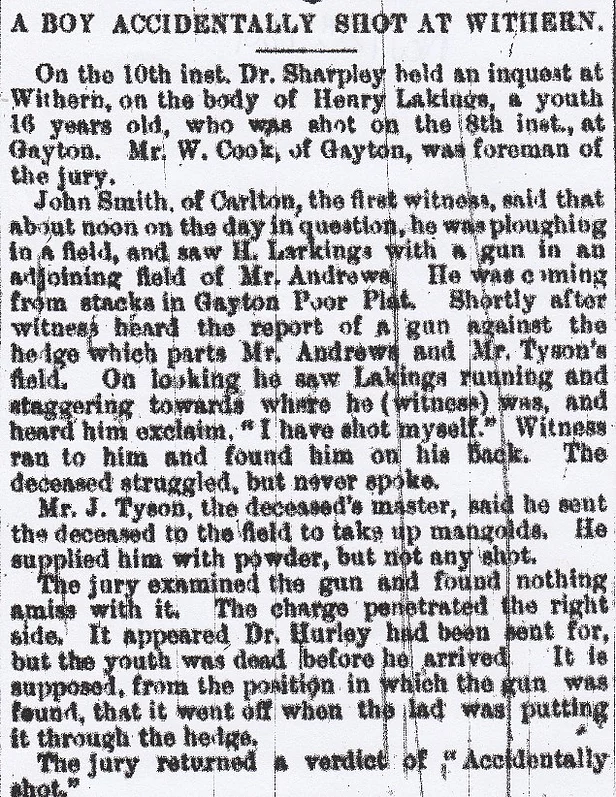
43/ Withern Suicide, October 1877
Mrs Susannah Brooksom, a widow, committed suicide by cutting her throat with a razor. She was staying at the house of Mrs John Allett, her sister. Mrs Brooksom lost her husband a few months ago and was enticed to sell up and to go and live with them in Yorkshire. The plan was not successful and she came back to Withern, but friends noticed that she was down in the dumps all the time. A niece was staying with her when Mrs Brooksom told her to go and get a box but she had something under her apron and was acting suspiciously so she declined. The aunt pulled out the razor and slit her throat in front of her with the niece running screaming from the house. When neighbours arrived, the floor was soaked with blood and her head was nearly severed from the body. It was deemed “Temporary Insanity”. She was forty-nine years of age.
44/ Withern, July 1882 (Cart Accident)
45/ Withern Mill Fatality, November 1881
A man with a great Dickensian name of George Tickler who was resident for fifty-five years, who was miller at Withern between Louth and Alford, met with a serious accident which proved fatal a few hours later. He was trying to start the wheel of the mill by treading on it, and when it started he didn’t get out of the way in time and was crushed between the wheel and the “beast-board”. Henry Needham, who was in the mill at the time of the tragedy, said it was necessary to have the water-wheel turned to get the belt on inside the mill. The wheel was being trodden on the inside by Needham the proper way, and incorrectly by Tickler. He told Mrs Tickler what had happened and together with the maid and a boy, they lifted him out. The doctor found him in bed with several ribs broken and deceased was aware he was dying. He expired a few hours later. “Accidental death”.
46/ Longlands Farm Suicide, Withern, January 1879 (Still there! Down Stain Lane)

47/ Swallow near Caistor, November 1976 (Vehicle Crash)
Three young persons from Grimsby were killed when their pick-up was involved in a head-on collision with an articulated lorry near the village of Swallow. Francis Paul Vergette aged twenty-one, along with passengers Amanda Jane Usher aged seventeen and Peter Robert D’Arcy, were on their way towards Caistor when the accident happened on a bend on the A46. The driver of the lorry escaped with minor injuries. Unlike the Victorian times, there will be hundreds of these types of an accident on Lincolnshire roads.
48/ South Elkington, February 1866 (Fatal Accident)
A fatal accident occurred just outside Elkington village when three waggons from Ludford were on their way to get laden with bones. The horses in a line of three waggons suddenly reared up and galloped past them at full speed, and this scared the horses in the second spot, and Stringer the head waggoner tried to maintain control of them and while turning to ascertain the cause of all the commotion, he saw the dead body of John Rands, a 25-year-old stout man, lying on the road, terribly crushed. Rands horses had become disengaged and ran off, with the shaft horse overpowering and him being by his own waggon. The horse ran into a ditch and broke its neck when it fell over. All the waggoners were sober and it was ruled as an “Accidental death”.
49/ Cotes Grange is in between South Elkington and Kelstern, (Dead Child Found) November 1877
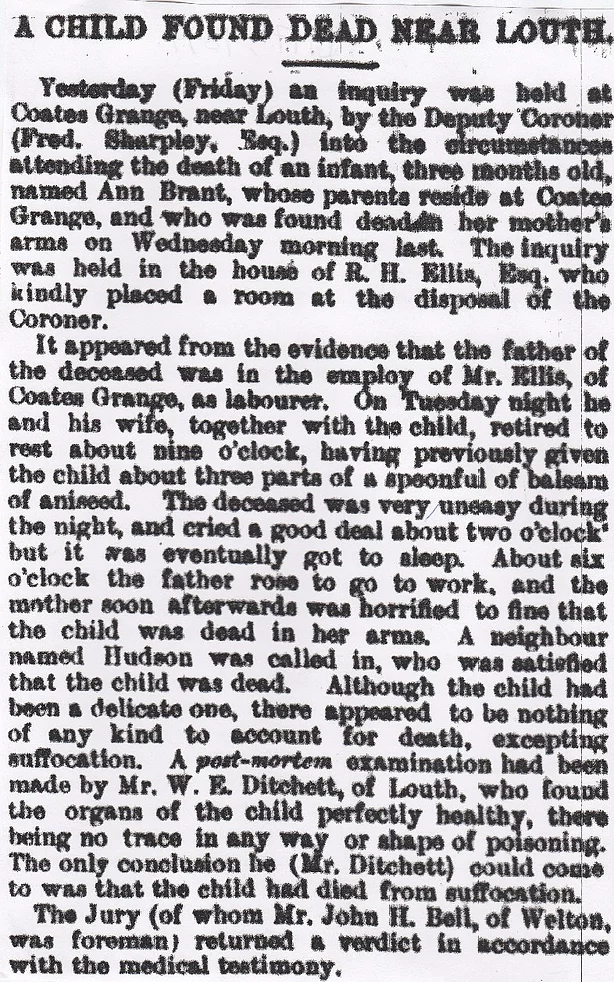
50/ Can anybody help me here! I have this postcard with an Ulceby postmark on the back, and dated 1907, but cannot identify what or where the building was located, it says on the back, that this is the place I work at- can you get my trousers done, and send them to me! Addressed to Finkle Lane, Barton.
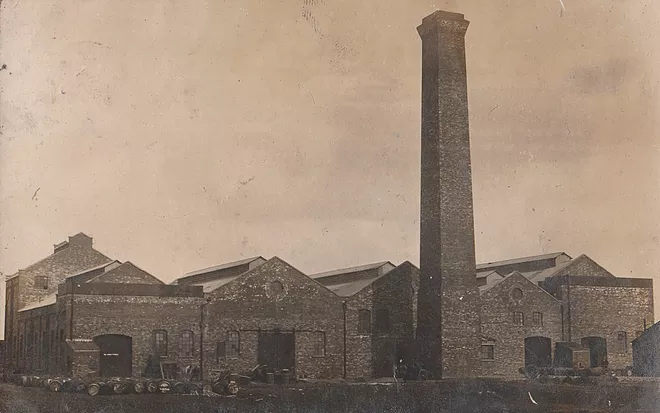
51/ Ulceby/Thornton Curtis, March 1876 (Attempted Wife Murder)
Martin Pinchbeck aged forty-one, a chimney sweep, was indicted for attempting to kill Catherine Pinchbeck by throwing her out of a moving train carriage between the stations of Ulceby Junction and Thornton Abbey. The couple had been to a relative’s funeral at Hull Cemetery and an argument ensued between them while on the train, and he told that the next funeral he be at, would be her’s. It reached a peak at Thornton Abbey Station when Pinchbeck was seen standing over his wife with blood on her head, and then lobbed her out of the carriage. He pretended to have lost his wife at Ulceby Station by calling her name. His wife was found on the side of the train tracks with a bad gash on her head and in a semi-conscious state. This lasted for weeks, and she is now mentally incompetent. Pinchbeck was given a year imprisonment with hard labour.
52/ Thornton Abbey Station Death, December 1873
An elderly gentleman was run over and killed at the station at Thornton Abbey. A passing Manchester, Sheffield and Lincolnshire Company train was responsible for his death. (Name?)
54/ Ulceby Junction Station Fatality, April 1880
At Ulceby Railway Station on the M.S.and L Railway, as an engine and tender were proceeding from a siding up the line, to be joined by a train on its way to Grimsby, W.B.Strickland, the station master, while crossing the line, was knocked down and killed. His body was terribly mangled with both legs and right arm almost severed off. Strickland had been station master for fifteen years.
55/ South Reston, (Body Found) November 1881
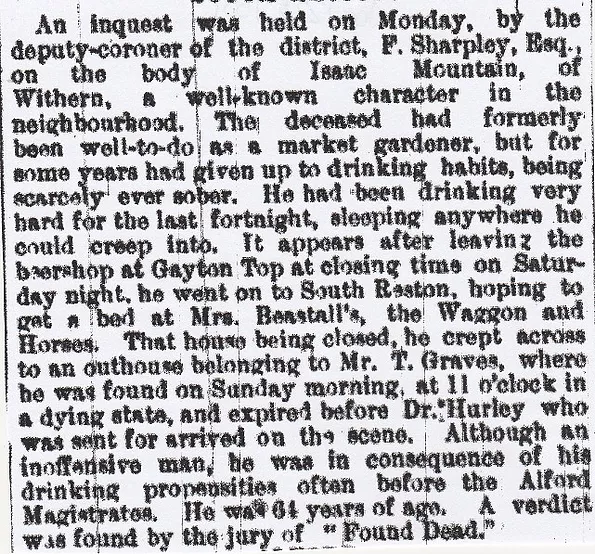
56/ South Reston Double Murder, July 1890


nothing whatsoever to do.
57/ Worlaby (Elsham) April 1914 (Gun Accident)
Tom Duffill aged fourteen years, was discovered in a field at Worlaby with serious gunshot wounds. His father came across his body and Tom murmured “shall I go to Heaven Dad?”. Tom had been using a gun to scare crows for a local farmer and when he leaned on the muzzle, the gun accidentally fired its contents.
58/ Worlaby, November 1976 (Boy Crushed to Death)
A 15-year-old boy was crushed to death when he fell off the ladder of a potato harvester and was crushed by the huge tyres. Saul Ben Randall of Garden Cottages, Elsham Hall, had the accident at North Wold Farm in Worlaby. Children used to ride the harvester, four at a time and one would follow it picking up loose spuds and Saul was this child and tried to climb on to get a lit back uphill. This was a tragic accident and he was found with a huge tyre mark on his chest and on the side of his face. The coroner said he died from shock and haemorrhage.
59/ Welton-le-Wold Suicide, June 1878
John Hurst, a retired farmer of Welton-le-Wold, has committed suicide by cutting his throat with a razor. He was said to have been depressed for the past year or so due to a loss in a farm which he rented.He was fifty-seven years of age and had been constable in the village for quite some years. A child named Stainton saw him laid down at the rear of the house near the closet and immediately told Harriet Webb the neighbour, who found him bleeding from the awful gash across his throat. He had suffered a stroke last October and was paralysed and was low-spirited because of this. That along with the financial losses must have preyed on his mind very much. Death was from the self-inflicted wound to the throat and he was said to be of unsound mind.
60/ Welton-le-Wold, September 1878 (Child Death)
Betsy Oliver, a young woman from North Thoresby, came to live at Welton-le-Wold to attend the wife of a man named Marshall who was very ill and has since died leaving five children. She had been there a few days when she gave birth to an illegitimate female child who was baptised on Sunday last in Welton church, it then being a month old. On Monday, the child was found dead in bed and a neighbour was sent for. The body of little Annie Oliver was viewed and she admitted she gave the child ten drops of “Godfrey’s Cordial” as it seemed unwell. It was thought to have died of a convulsive fit. “Accidental Death”.
61/ Willoughby Station Fatality, (Alford) June 1889 (Did she make it?)
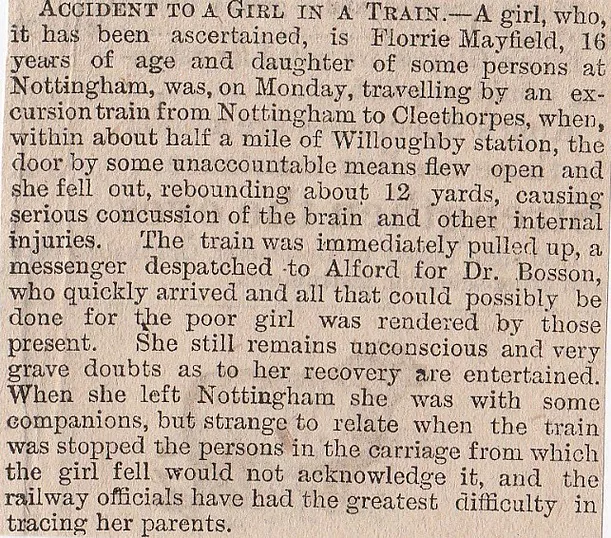
62/ Willoughby near Alford, July 1874 (Attempted Poisoning)
A domestic servant named Mary Ann Gunby was committed for trial at Lincoln Assizes for attempting to poison her mistress, Mrs Farrow, wife of Mr T.Farrow, a farmer of Willoughby. The prisoner was hired at May-day but not liking the place she wanted to leave but her employer would not let her; the prisoner, therefore, purchased a packet of Battle’s Vermin Killer and mixed part of it in her mistress’s tea. She acknowledged the offence prior to committal.
August 1874 (Sentence)
At the Lincolnshire Assizes, Mary Ann Gunby, domestic servant, aged twelve years, was found guilty of feloniously administering poison to her mistress, Mrs Frances Farrow, at Willoughby, on July 11th,1874, and sentenced to fourteen days imprisonment and afterwards to be confined in a Reformatory for five years.
63/ Willoughby Station Fatality, November 1881
William Bamber and John Baines were walking down the line from Alford to Willoughby, when near a hut between Willoughby Station and the gatehouse nearer Alford, they found the dead body of a man. It was reported and it appeared that the man was struck by the mail train and dragged about fifteen yards with the wheels severing an arm, tearing his trousers and pulling his coat up to his neck as it mangled him. He also had a fractured skull and laceration of the breast with bone fragments along the railway line. The body was later identified as Charles Goodhand from Sloothby aged 58 years. Apparently, the son told of how deaf he was and he was not always a sober man. The verdict was “Accidentally killed by an engine on the railway, whilst trespassing thereon”.
64/ Saucethorpe (Spilsby) September 1859 (One in a million)
At Saucethorpe, a little boy in crossing the farmyard with a thatch peg in his hand, stumbled over some article being in his way and fell upon the pointed end of the peg which penetrated his chest causing his death within twenty-four hours.
65/ Scamblesby Suicide, March 1879
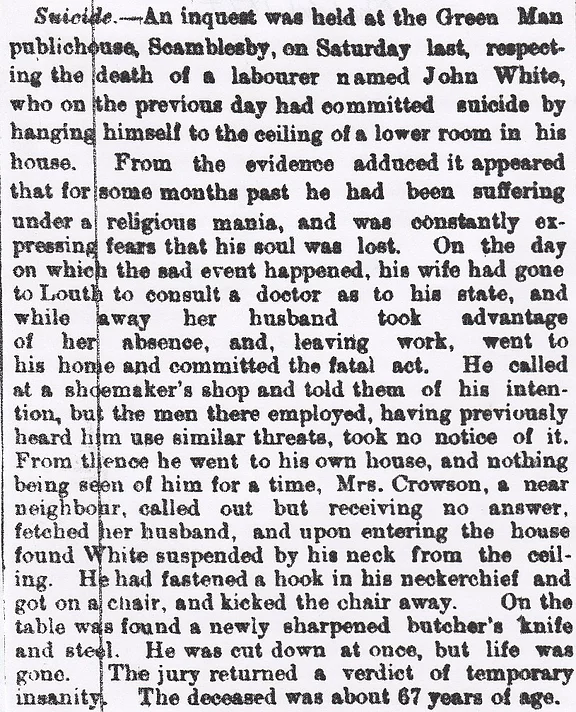
66/ South Ferriby Decapitation, (Barton) December 1866
One Monday evening an accident occurred, involving William Woods who was the manager at the Lincoln and Lindsey Bank, Brigg and also owned a bone mill at Ferriby Sluice near Barton. He went to Barton Market and having had a slight accident to his gig he had a couple of jars in the Wheat Sheaf until it was repaired. He left a couple of hours later and drove off to Ferriby, four miles away. When he got to the mill he told the foreman to crank up the engine as he wanted to see it working for himself. He did, and he got too close to the mechanics of the engine and it snagged his coat and dragged him through the cogs and flywheels, decapitating the fellow in the process. He was forty-four years old and leaves a widow and five children.
67/ Saxby All Saints, (Barton) March 1872 (Mass Poisoning)
Over a dozen people were poisoned accidentally by some refreshments provided at a funeral of Mrs Hutchinson at Saxby near Barton. They had some rice pudding and when they then walked along in the funeral procession, they began staggering about and getting dizzy. Then they vomited and were taken home to bed. The surgeons called in and they spotted that it bore all the hallmarks of arsenic poisoning. Eventually, most of them were alright. The late Mrs Hutchinson kept the arsenic in a tin and this was mistaken for ground rice and that was put in the pudding that day.
68/ Winteringham, December 1874 (Inhuman Act)
Ann Swanwick aged nine died of exposure to the wind and waves on the River Humber. Captain Swanwick’s ketch and five other vessels were being towed by a tug from Hull. The captain’s name was Philip Ullthorpe and he took them to the Lincolnshire side of the river. Early next morning the ropes were cast off and the ships left by the tug, which made its way back to Hull. The vessels collided and two sank. Swanwick, along with his wife and child, were left to fend for themselves but they were rescued by ropes, but the little girl died in the arms of a seaman shortly after. Swanwick is on death’s door and his wife is in a critical state. Ullthorpe was asked to keep to the Yorkshire side but ignored that, and he was hailed as an unfit captain of any vessel. It was thought that Ullthorpe deliberately cast off the ropes and left them to their own devices. He was charged with “Manslaughter”.(What sentence did he get?)
69/ Sloothby Death, May 1888
70/ Trusthorpe, March 1904 (Body On Beach)
At Trusthorpe near Mablethorpe, the corpse of Miss Loft was discovered floating in the sea. It was found by Miss Francis of Newstead Lodge, Mablethorpe, whilst out for a stroll along the beach. Coastguards were called in and tried to resuscitate her but she was too far gone. The deceased left Mablethorpe on the Wednesday in order to get married.
71/ Snelland, (Inhuman Treatment) (Market Rasen/Lincoln) February 1860
A farmer named Peel, committed an assault upon a member of his farm labourers, who had since died from the attack. Deceased was a young lad, not very intelligent, who was ill-used by Peel and treated with the utmost brutality. He hung him in a stable till he was nearly dead on one occasion and another time struck him with a fork-shaft. A verdict of “Wilful Murder” against Peel. (What happened to him?)
72/ Scrivelsby Rectory Suicide, August 1901
The Reverend C.E.Chapman was found shot through the head from a self-inflicted wound, in an outhouse at Scrivelsby Rectory near Horncastle. He was an athletic man and taught at Llandovery Boys School and played cricket for them as well and earned an England cap for Rugby, where he played as a three quarter.
73/ Stenigot Fatality, October 1868
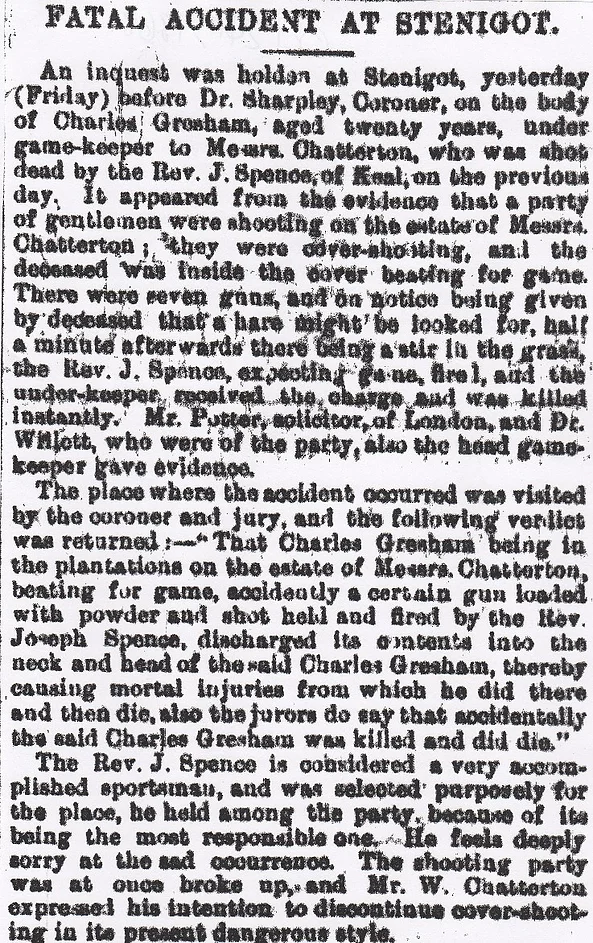
74/ Westlaby, near Wickenby Aerodrome, May 1844 (Infant Remains)
A bundle containing a dead infant was discovered at Westlaby near Lincoln, but it was kicked among some ivy. The villagers were concerned and searched for the remains, but it was all in vain as the child seemed to have just vanished. While all this going on the housekeeper to Mr Tongue the rookery owner, Anne Robinson, killed herself by taking laudanum. The mother was accused of “Wilful Murder” against the child and was then revealed to have committed suicide at the inquest.
75/ Winterton near Scunthorpe, February 1849 ( Made to Milk Cow Naked)
An awful outrage was committed at Winterton by John Sunman aged twenty-eight and Alick Johnson aged twenty-six, who stalked the girl over a field, then made her perform her work of milking the cows while stark naked. Sarah Ann Neal, who is a domestic servant at Winterton told of how they stole her skirt, petticoat and gown, and made her perform her work then gave her an old grey coat to go home in. Prisoners were sentenced to seven years transportation to Australia.
76/ Toynton St Peter (Spilsby) December 1867 (Attempted Murder/Suicide)
Samuel Robinson, an ex-solicitor in London but who lived in Gravesend, went down to see his brother in Toynton St Peter near Spilsby, to change his will in favour of his children instead of leaving everything to his own wife. He was told in no uncertain terms to “Bog Off”, and he then became enraged. He stayed for tea and afterwards Mrs Robinson was outside doing the dishes, he jumped out with a shotgun and fired at her twice, missing both times. He then scarpered and then three shots were clearly heard. His brother found him and asked why he had done this foolish act, his brother simply inquired if his wife was dead. When told she was alive, he said “That is a bad job. I have three bullets in my body”. He then died within the hour.
77/ Wrawby Junction Report, January 1899
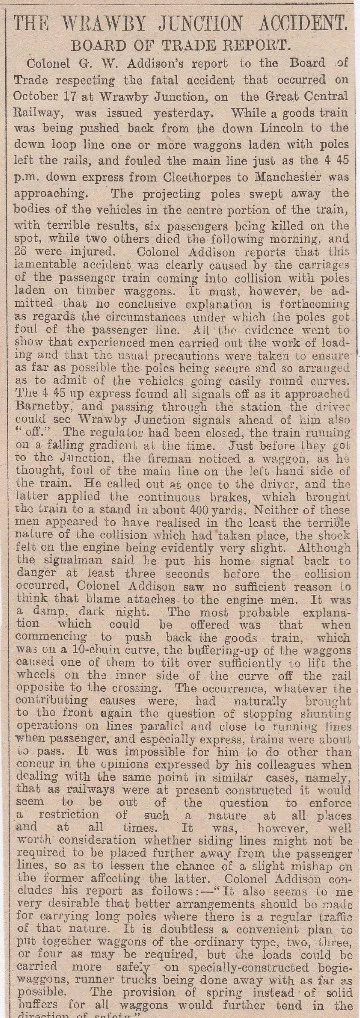
direction of safety.
78/ Stainton-by-Langworth, November 1976 (Train Fatality)
A woman from Holton-le-Clay near Grimsby was killed when she fell from the King’s Cross to Cleethorpes train at Stainton-by-Langworth, between Market Rasen and Lincoln. Kay Sullivan from 31, Holt Mount, fell when a door was thought to have accidentally unlatched itself, with Miss Sullivan thrown out.
79/ Welton Church Lightning Stike, near Lincoln September 1847
One person lost his life and five women and three men were seriously hurt, when the church at Welton near Lincoln was struck by a bolt of lightning. While the congregation were singing a hymn, the Reverend Williamson had just ascended the pulpit and the lightning entered the belfry, then there was a sudden explosion. The congregation began to shout and scream and there was mass panic as they all headed for the exit. The people inside who were injured were laid on the floor, clothing alight and the women with blackened faces. The dead man, Mr Brownlow, a wheelwright, aged sixty-eight was found at the bottom of the pew, under a chandelier, quite dead. His buttons melted, his trouser leg was ripped open and his coat was in shreds. The lightning struck the south-eastern pinnacle first then went down the battlement. Then it went through the tower and partially melted a portion of the clock face. Where Brownlow stood, the current passed through his body to the ground.
80/ Thurlby Suicide, April 1892
Eliza Wilkinson aged sixty-five, who lived with her husband in a cottage in Thurlby near Alford was found dead under remarkable circumstances. Her husband had been away visiting a friend and Eliza decided to stay with her son at Bilsby, not far from home. Her son’s wife went to meet her at Thurlby and on entering the premises she found Eliza on the floor, covered in blood, with a large self-inflicted razor wound on her throat.
81/ Thimbleby, November 1888 (Same Day Deaths)
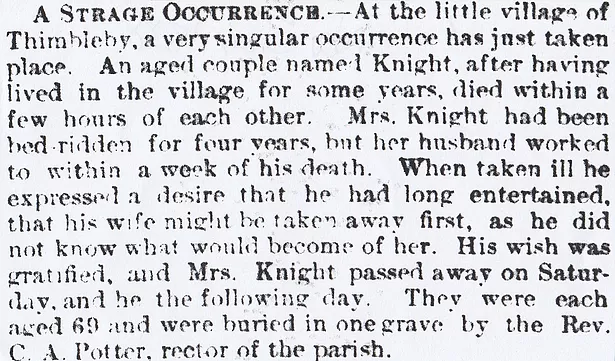
82/ Westwoodside near Epworth/Haxey July 1861 (Mother Drowns Three Children)
Ann Wilson woke her three children, Lucy, William and Elizabeth and drowned them by putting them in the cistern, under the kitchen floor and covered it over with a stone. The water was only a couple of feet deep so she held them under with a mop, then put the stone back. The ages of the children were seven, four and a half and two and a half. When she finished her dreadful deed she went to Wheatley, to her father’s house, where the husband was staying. Police arrested her at Wheatley and charged her with wilful murder and with no fuss, she kissed her father and calmly said that she was guilty of the crime. The verdict was that she was guilty of the murders but was of unsound mind at the time.
83/ Southrey near Bardney, June 1812 (Three Killed in Lightning Strikes)
Three youngsters by the names of John East, Richard Pask aged twelve and eleven-year-old Levi Day were tending geese, with another lad, Charles Blakey in the little village of Southrey, between Horncastle and Lincoln. A storm was brewing and when it hovered above them they took shelter in a rudimentary hut. The next thing Blakey remembered was shouting at the boys to get out, but they never responded so he ran home to get assistance. Help arrived but it was found that the place was struck by a bolt of lightning and the other three were dead. Their necks, shoulders, faces and chests were all charred and inner clothing was burned off their backs, but the outer garments were unscathed. (Where are they buried?)
84/ Tetford Suicide, February 1880
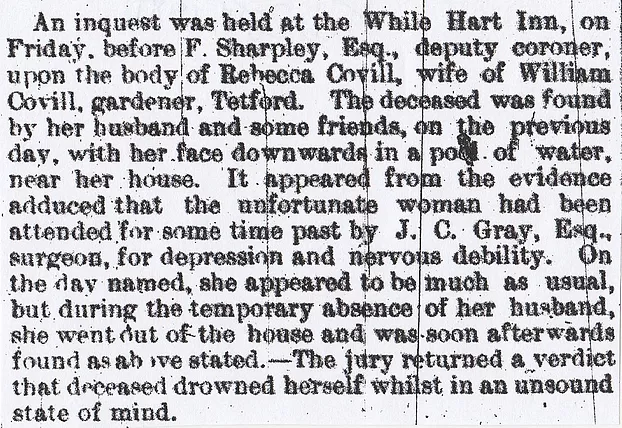
85/ Sutton-on-Sea Poisonings, June 1890
A married woman named Mackinder from Sutton-on-Sea died from arsenic poisoning. She had made a pudding for the family and put arsenic in it, in a deliberate bid to wipe out the whole family. One of the children commented on the food tasting funny and the mother knowing full well what was in it, told her to sprinkle some sugar on it. The eldest son whose head was screwed on, told the other kids to leave it alone. A doctor was called in but the mother died in the evening and the son is in a dangerous condition. Apparently, it all stemmed from the mother spending her husband’s sick allowance and didn’t want to be around when he discovered what she had done.
86/ Sutton-on-Sea August 1883 (Gun Accident)
At Sutton near Mablethorpe, a chap named William Jackson who was a foreman for Mr Brooks, a farmer, was out shooting rooks. He got hold of a sparrow gun and put in twice the amount of powder and then fired it, causing the barrel to explode and some of the metal lodging in his skull. The explosion also caused a portion of his face to be blown off, causing instant death.
87/ Strubby, July 1882 (Drowning by Epilepsy)
George Holmes died at Strubby, with the cause of death was returned as “Death by drowning whilst in a fit”, which in my book means, he had an epileptic seizure in some water! He was mowing out the Skybeck drain with John Simpson working nearby. Simpson saw him working and when he passed him twenty minutes later, he discovered the body, face down in the water, which was only three feet deep. He pulled him out and tried to resuscitate him but to no avail. His doctor said he suffered from epilepsy. He also leaves a widow and several children.
88/ Strubby Suicide, September 1880
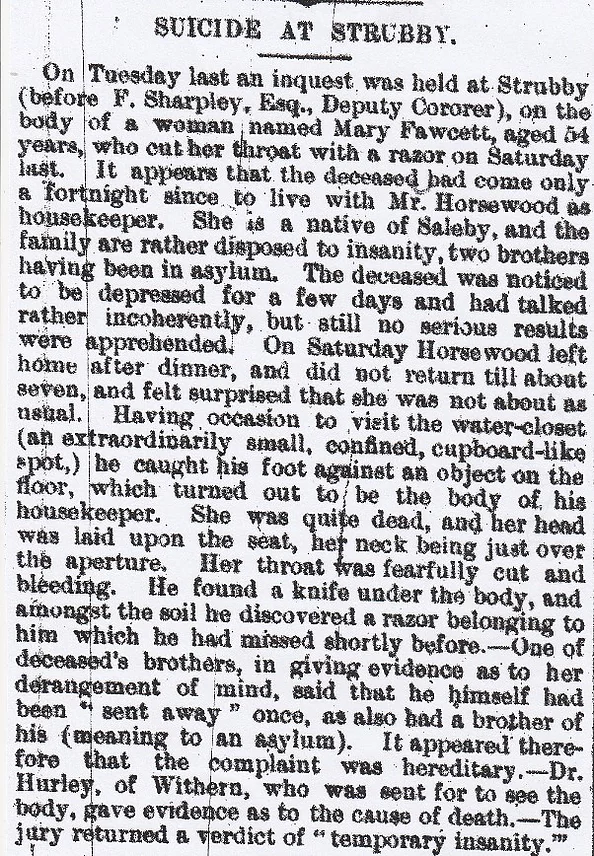
89/ Welton Wood, near Alford, April 1879 (Burned to Death)
Seventy-eight year old Edmund Frost had served as the woodman to Baroness Willoughby de Eresby at Welton Wood for fifty years or so, went missing one evening. His son and a neighbour searched the fields, then saw some burning embers of a fire which had covered approximately three acres. In the centre was a charred corpse with the clothes still smouldering. It is thought that he lit a pipe, threw the match down and ignited the brush and twigs around him which caught fire and burned him to death.The right arm was bent as though protecting his face and the contents of his pockets/; a watch, knife and pipe, with a tobacco-box were all blackened by the inferno. He also is thought to have choked on the smoke fumes, fallen over and then passed out and then been consumed by fire.
90/ Welton-le-Marsh, December 1873 (Child Murder)
Emma Wilkinson aged twenty-three, servant, was charged with the wilful murder of her infant at Welton-le-Marsh on 7th December 1873. The prisoner was a cook in the Rector’s family at Welton, and suspicions arose, so a doctor was called in to examine Emma and he consequently accused her of having given birth to a child. Emma confessed and the child’s body was found in a bundle with a handkerchief tied tightly around its neck. She was found guilty of concealment of birth and was sentenced to eight month’s imprisonment.
91/ Tathwell, May 1870 (Accidental Drowning)
A sad occurrence took place within a few hundred yards of Kenwick Thorne Bar in the parish of Tathwell. There are one or two labourer’s cottages in the vicinity of the lane (Poverty Lane), which leads from the London Road (A16) to Tathwell and a deep pond is adjacent thereto. All the children were playing around here, when a child fell in the pond, when the mother named Carter, along with another woman named Rhodes, hastened to rescue the child. Mrs Carter dived into the water but rather than help the child she seemed to become paralysed and when the child was rescued, she was dragged out and almost instantly expired. The coroner said the death was caused by the sudden shock of excitement and the coldness of the water, along with deceased being heavily pregnant. The husband is now left with three motherless children.
92/ Tathwell Drowning, August 1859 (Not same pond as above, is it?)

93/ South Willingham, July 1883
A dwelling house at South Willingham near Louth was struck by a bolt of lightning, killing the male inhabitant inside. In the same storm, nine sheep and a cow were also struck and killed.
94/ South Willingham Suicide, August 1888
In the village of South Willingham between Wragby and Louth, a young lad was working in the fields, scaring birds when his lifeless body was discovered hanging head downwards from a tree, with his throat slit from ear to ear. (Boys name?)
95/ South Willingham Landslip Death, July 1864
A labourer named William Smith aged thirty-one worked for a local farmer, Mr Chatterton. Deceased went out with two other men, carting marlstone, for agricultural purposes, from a pit on Mr Heneage’s estate. One side of the pit was undermined to, so as to economise labour and secure a large fall. The problem was this fell on them while they were working with two escaping, but Smith was buried up to his shoulders, and so fearfully crushed that he died within two hours of being extricated. He was married with one child and ironically his wife was on her way to the pit, with his breakfast when the landslip occurred.
96/ South Willingham Station Suicide, July 1881
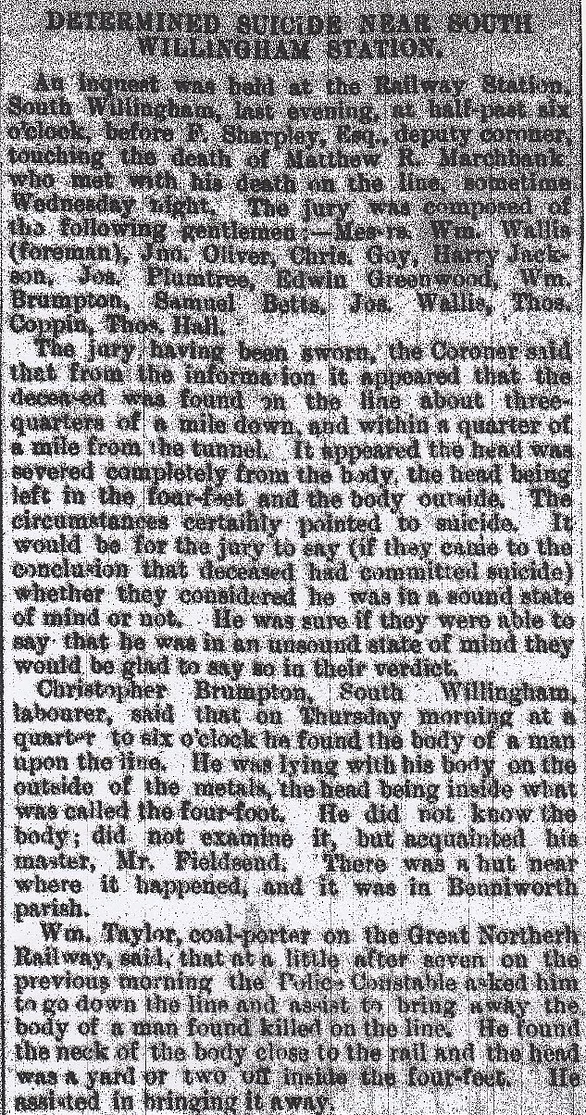
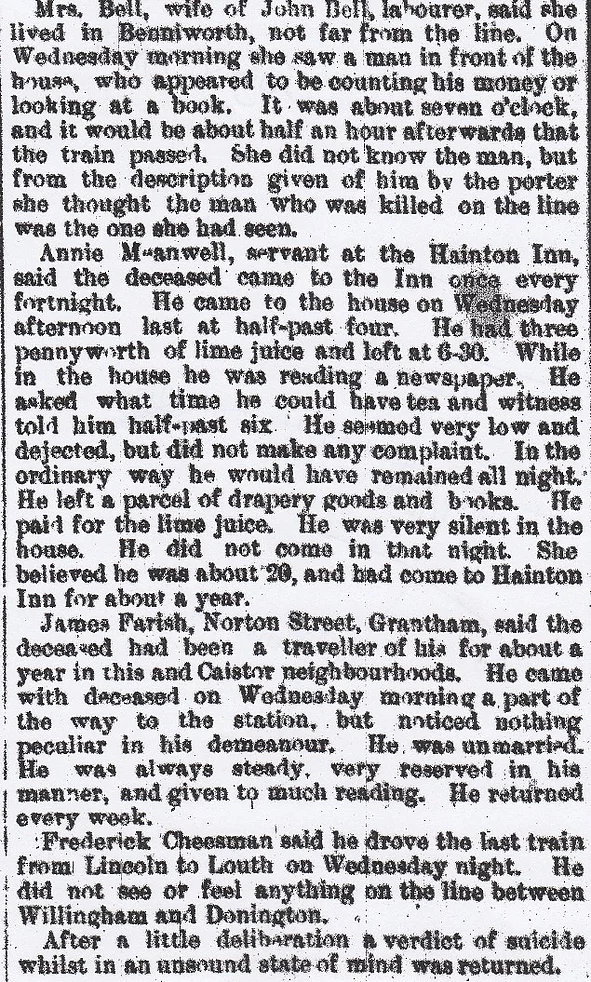
South Willingham and Hainton Station were south of the village, between there and Benniworth. The tunnel mentioned is about a mile east of that.
97/ Whitton, October 1876 (Shocking Cruelty)
James Dalton was a clerk at a solicitor’s in Hull and he killed himself by jumping overboard from a New Holland packet, while in the centre of the River Humber. What happened after his corpse was discovered leaves nothing to the imagination. When he was found floating in the Humber by the captain of a tug, the captain sent a man in a boat, to drag in the body then row to shore with it, all of which he did. He got to shore near Whitton on the banks of the Humber and tied it to a stake and abandoned it there. A witness, Mr Barley, saw the man do this, then row off back to his ship. He thought it best to inform the local police but they refused to get involved, thus the corpse was left out in the open until the inquest some days later. The coroner said the conduct of the local population and of the policeman, bordered on inhuman. When the pockets were searched, a third class ticket between Hull and Beverley and a scarf pin was found. It was only by the latter that the body was identified because the facial features had virtually been eroded away.
98/ Whitton Ness, (Humber) (Shipwreck Escape) May 1885
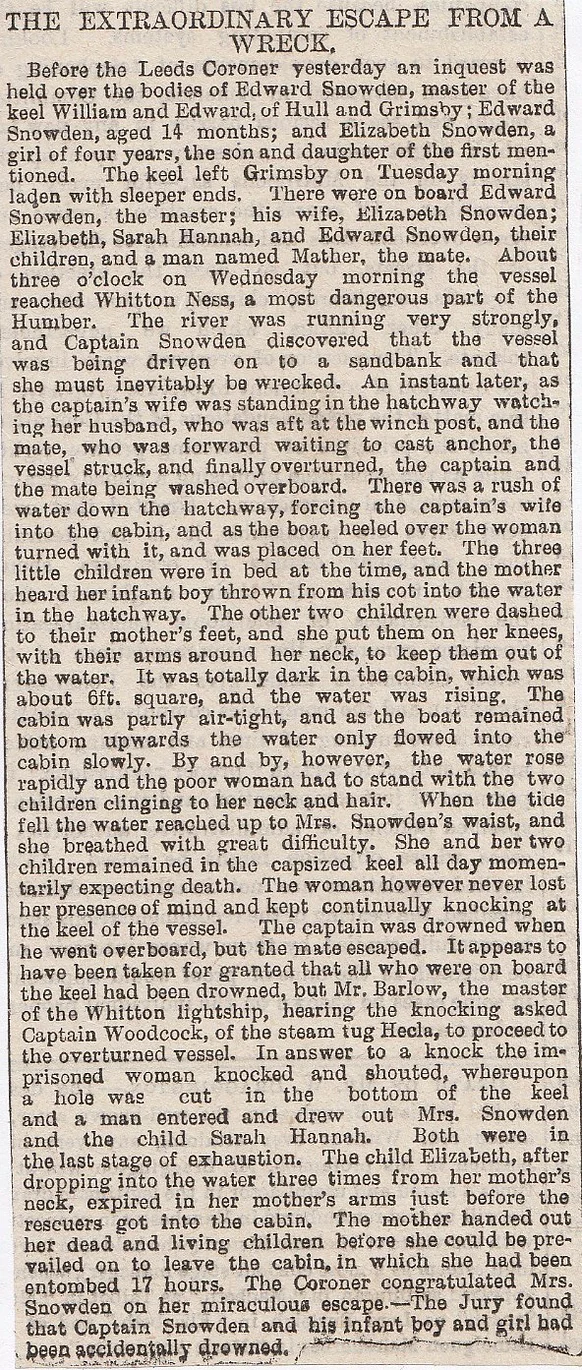
99/ Saxilby Child Murder, September 1859
Seventeen-year-old Sarah Ann Bellamy who worked for a farmer in Saxilby, Mr Capes, was charged with having wilfully murdered her male child. A doctor was called for one day and she complained of back pains and having sickness, for which she took some pennyroyal (a herb-pudding grass). The surgeon was suspicious and believed her to have had a child but she resisted attempts at an examination. The next week he saw her again and was sure she had been delivered of a child, so he informed the police. They quizzed her and searched the premises, where they found a dead baby boy in a box with a thick tape around the neck. The child, described as a fine, healthy one, was born alive and the mother strangled it with the cord or tape. (What happened to her?)
100/ Saxilby Station Fatality, November 1849
Three labourers were on their home from work, walking down the train tracks in the dark near to Saxilby Station when they spotted a luggage train coming towards them. They nimbly moved out the way only to be struck by another luggage coming in the opposite direction, which they had neither seen nor heard. One man was killed on the spot and was fearfully mangled, with his entrails spread all over. The second was badly injured and chances are that he may not make it. The third was extremely lucky and was thrown clear down an embankment.
101/ Stow Murder, (Lincoln/Gainsborough) November 1850
Christopher Page from Stow Park was poisoned and his wife was fatally poisoned. Mr Page was in a serious condition and the servant, seventeen-year-old Eliza Smalley was accused of administering the fatal dose. It seemed that arsenic and mercury was boiled, to be mixed with wheat. A portion was left in the pot and then locked away, with the key brought to her master. Mrs Page suffered from a burning tongue and severe stomach cramps. Mrs Page had coffee at breakfast and Smalley confessed to putting the mercury in her coffee. Her employers treat her well and she hadn’t been to church since she worked there and was illiterate, but she knew right from wrong. “Wilful Murder” against Eliza Smalley.
102/ Stow Station Fatality, October 1886
An inquest was held regarding the body of Tom Smith, who with two other waggoners went with a team to Stow Station. On the way, they stopped off for a few beers….then a few more…..and a whisky chaser. When they returned, one of the teams of horses galloped off and Tom was knocked over and killed.
103/ Scawby Poisoning, February 1888
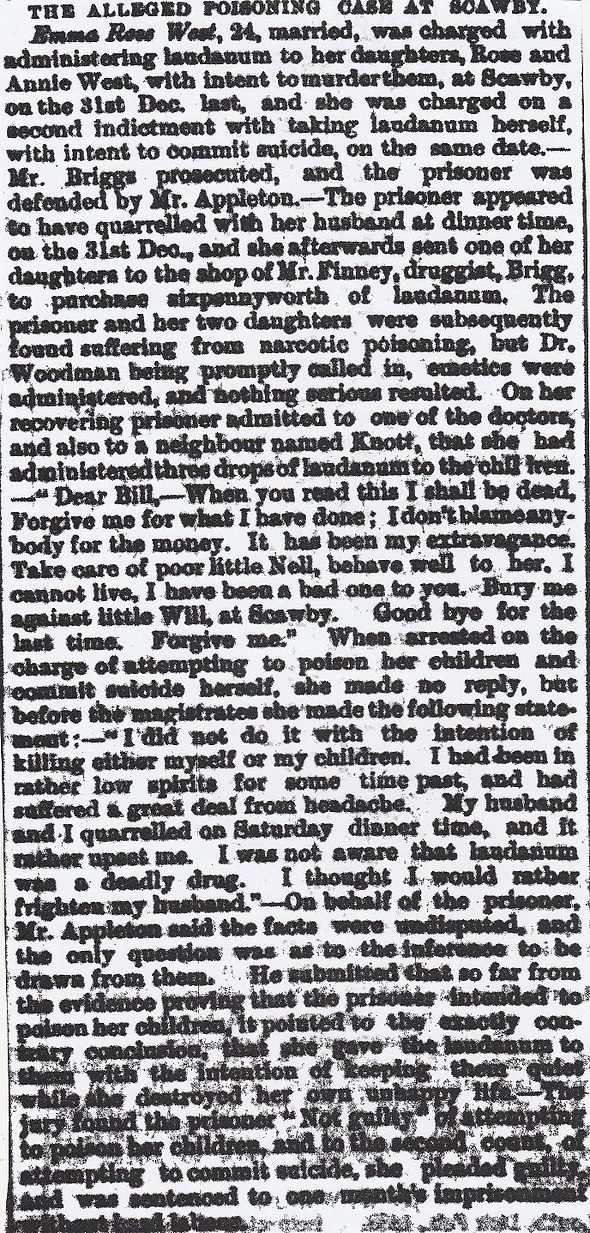
104/ Scawby Hall Fatality, August 1881
Mr J.Wilson, agent to Captain Sutton of Scawby Hall, Brigg, was found lying on a stile on the estate, shot through the head. He was alive when found but died soon afterwards. He had gone out with his gun to look over a portion of the estate. The weapon was found discharged by his side and it is conjectured, in the absence of any direct evidence, that while Mr Wilson was crossing the stile, the trigger caught in something and the contents of the gun was lodged in his head.
105/ Scawby Brook (Brigg), May 1883 (Child Death)
(Scawby Brook, the park on the bend of Scawby Road?) Alfred Patterson aged ten years, the son of a widow and living at Scawby Brook, was with another lad named Smith and they were playing in Scawby Park one afternoon. Patterson climbed a tree to get to a rook’s nest and when near the top, the branch snapped and he came hurtling down to the ground, a distance of around forty feet. He had a fractured skull with the brains slightly protruding and his arm fractured as well. He died the next morning.
106/ Wood Enderby Skeleton, June 1887
While some men in the employ of Mr Coney, a farmer of Wood Enderby, were gripping in a field belonging to the latter, they came across a human skeleton. The bones were evidently those of a full-sized woman, being too fine for a man’s frame. Unfortunately, the men in digging had broken in the skull or the skeleton might have been preserved whole. (Where is the skeleton now/Who was it?)
107/ Somerby Crossing Suicide, near Brigg, March 1878
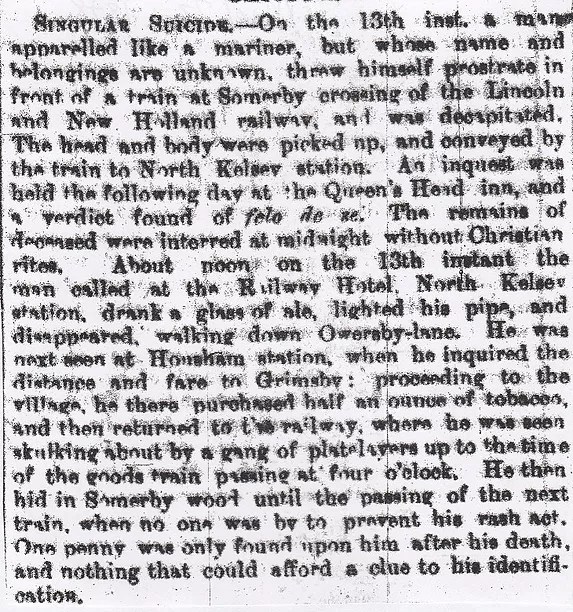
108/ Woodhall Spa Suicide, August 1899
A young man named Whitlam, who was a violin-player in the Woodhall Spa Band, killed himself. He left a note saying that he intended committing suicide, then drowned himself in a local pond, all because of a love affair. (What pond?)
109/ Stixwould Grange near Woodhall Spa, April 1875 (Siblings Drown)
Firstly, I’m not sure if this the Stixwould near Woodhall Spa! There is a Grange Farm, down Green Lane. A pair of siblings named Almond, who were aged three and four, were feeding the ducks on a pond at Stixwold Grange in Lincolnshire when for some inexplicable reason they tumbled head first into the water. They were both drowned before they could be rescued.
110/ Thoresthorpe Suicide, near Alford, August 1879
A young woman killed herself by jumping into “Robinson’s Pit” at Thoresthorpe near Alford. An attractive eighteen-year-old named Sarah Ann Turner was spoken to by several persons on Tuesday evening, but a man named Barnes said she seemed really depressed and troubled. Mr Barnes was the last person to see her and she was heading in the direction of the pond. Two men named Davidson and Kidd saw her approach the water-side but couldn’t determine if it was a man or a woman as it was dark. They saw them head for the bather’s shed, then lost sight of them. They then observed the person, walk to the edge, then sprang in and disappear under the surface. They informed Mr Robinson who called on police to attend. They tried to recover the body but she was eventually found after being in the water for an hour. Her hat, jacket, linen cuffs and boots, were placed neatly on the bank. The young girl had been crossed in a love affair and in her pocket were a couple of pieces of paper, with this written on them:
“Like a lily fair and green, Soon cut down and no more seen, Beloved she was, in peace she died, Her life was craved, but God denied. – My love is fair, so fair to see, My love is blind, he loves me not, But when the time comes round he’ll miss, The rapture of my Heaven-born kiss. – Beating heart, why thus lament? Woe is thine, then be content; Tho’ on earth no more we’ll rove, Softly sighing vows of love. – Softly your lips on mine were trembling, As I whispered low, Give me your love some token, Darling ‘ere I go.
Then was written in pencil “it would be useless. You will please to consider our engagement at an end. Do you ask for an explanation? Then your own heart will tell you if you have been true to me. Do not attempt to see me, it would be useless.”
The young man she seemed distressed about was Edward Robinson and told a friend she loved him and would die for him. Nelly Blythe, another friend, said she took a razor upstairs recently but prayed for a while, then found some relief. Her body was interred at the Cemetery, followed by a large number of family and friends of the Congregational Church.
111/ Wragby Drownings, May 1884
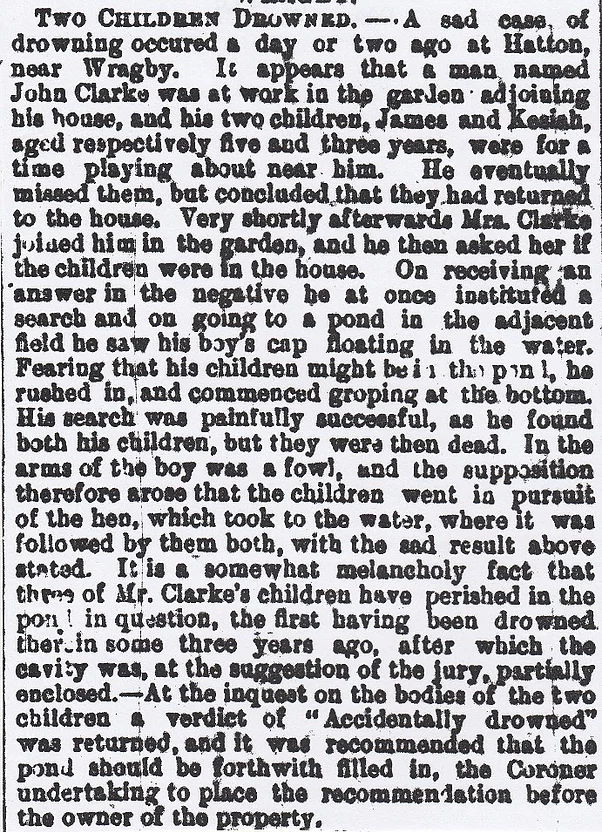
112/ Wragby Fatality, June 1862 (Drink Driving)
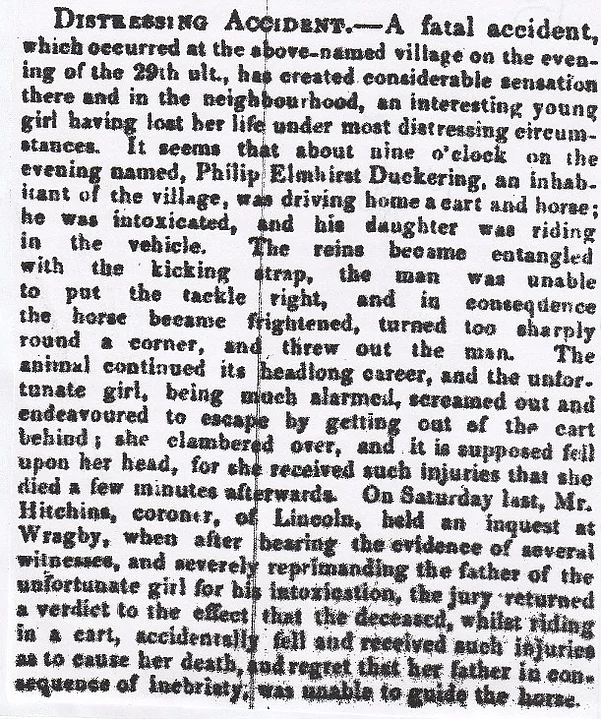
113/ West Keal Suicide, near Spilsby, November 1877
Jane Shaw aged fifty-nine, wife of George Shaw, farmer, committed suicide. She had been in a desponding state of mind for some time past and Dr Thimbleby warned her family that she was a suicide risk. In consequence of this, she was closely watched by her husband and her sister, Mrs Maddison. On November 3rd, Mr Shaw went down his grounds having first hidden a bottle of laudanum which he had on the premises for cattle medicine. He locked the barn door and supposed that he had taken every precaution, but in course of an hour, Mrs Maddison called him home. Deceased had broken into the barn and taken a large quantity of the poison. The jury found that deceased was deranged in mind and the verdict to that effect was returned.
114/ West Keal Church Tower Collapse, October 1881 (Behind Coffee Cup Cafe)
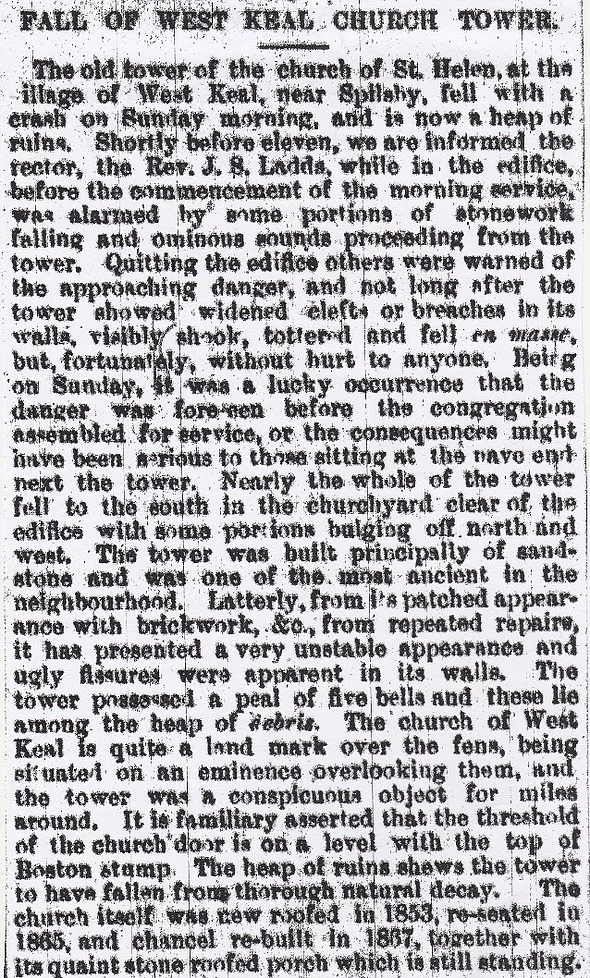
115/ West Keal Suicide, (Poplar Farm), October 1931

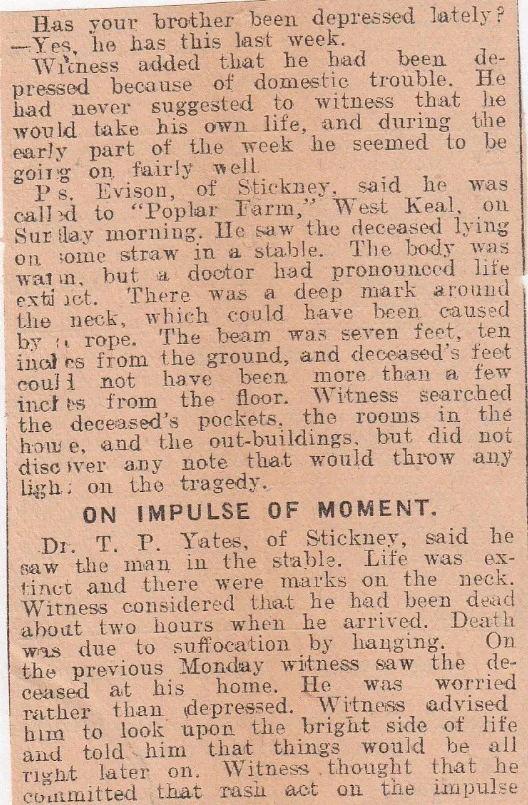
116/ Withcall Drowning, September 1859
At Withcall, the wife of William Marfleet, carpenter, whilst drawing a bucket of water out of a deep pit in the field, near her residence, slipped off the plank on which she was standing and being unable to extricate herself or make her voice heard, was drowned. One of her little boys becoming alarmed, at length ran to the pit and finding his mother had fallen in, ran for help, but before any could be obtained life was extinct. Six young children, by this catastrophe, are left motherless.
117/ Withcall, (Threshing Machine Accident) November 1875
Elizabeth Padley aged twenty-six and married, met with a horrific accident at Withcall on October 26th. Her leg was drawn into a threshing machine on the farm of Thomas Sowerby. She was brought to Louth Hospital, where the leg was amputated above the knee, and she sank gradually from that point on, expiring on Saturday morning. A witness who was working with her on Goulceby Top said her left foot and leg had been caught by the drum and held on to her before she was released after twenty minutes or so. He also said there was surprisingly little blood. All she kept saying was that her knee hurt and that she couldn’t feel her foot. The verdict of “Accidental Death”.
118/ Withcall Tunnel Death, December 1875
Cornelius Janway aged twenty-eight and from Cambridgeshire, met with an accident while at work, causing the death thereof, on the Withcall Tunnel. (There is a video on Youtube) He was crushed between two of the trucks and suffered a fractured elbow and had his left thigh literally squashed to bits. The accident happened about 500 yards in the tunnel, from the entrance on the Stenigot side. The waggons were laden with bricks, and deceased was riding on the buffer behind the waggon with his hand on the lever. The waggons got faster, then the lever went down, then a link in the chain of the brake-block broke, rendering the lever useless and then the deceased screamed out. He was freed and brought to Louth Hospital. Blood was oozing from his elbow joint, and the left thigh had a huge gash in it. His right testicle was hanging out, while the left had been driven into the abdomen, under the skin and the bladder was ruptured as well. The injuries were so bad that hope of recovery was remote. The surgeon also said the skin was torn from the flesh, due to getting caught between the wheel and track and getting dragged for some distance.
(The Withcall and South Willingham tunnels were closed in 1960, but they are now home to some rare species of bat, including Brandt’s bat, Natterer’s bat, Daubenton’s bat, Whiskered and Brown long-eared bat.)
119/ Withcall Tunnel Accident, January 1876
120/ Woodhall Spa Fatality, July 1887
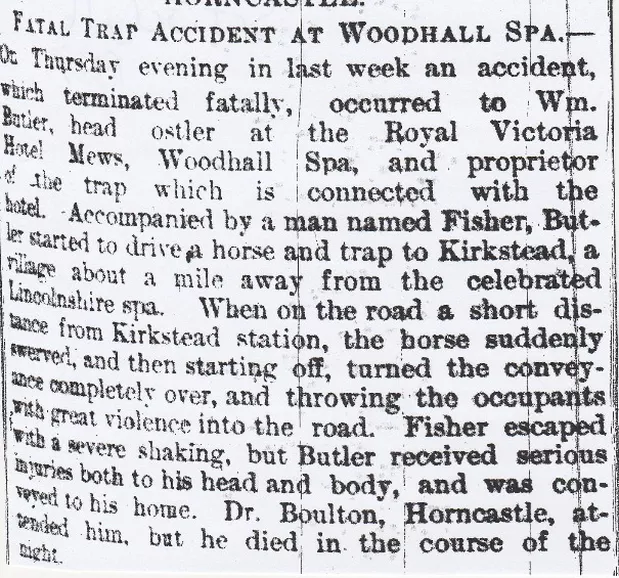
121/ Sutton-on-Sea Suicide, April 1888

122/ Saxilby Railway Death, March 1885
Gertrude Handley, a labourer of Saxilby near Lincoln, left her home on the 6th February at eight o’clock, to go into the village. The G.N.R. from Lincoln to Doncaster passes through Saxilby and Handley was in Crinsey Nook on the other side of the line, so she had to cross over. When she got to the crossing a goods train was passing towards Lincoln, and as soon as it passed she stepped through the gate and as another train was due, the gate-keeper called out to her. She spun around and was struck by the train, with the engine going over her foot. Gertrude was taken to Lincoln Hospital and they found her foot severely crushed, also with bad bruising on her body. She recovered but then relapsed, and gradually sank, dying the Saturday afterwards.
123/ Fossdyke Fatal Accident, near Saxilby September 1888
